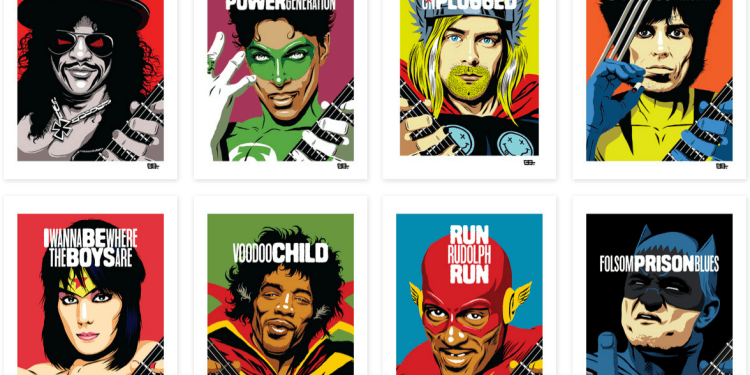WHAT IS DIGITAL ART?
Digital technology is at the core of significant change in many areas of our lives even in the cultural field made up of concrete and tangible pieces of art. Digital art, such as 3D virtual reality (VR) or computer graphic techniques, have become mediums that are now enabling artists to revolutionize traditional art forms. It is, essentially, a new tool that will serve a variety of artistic needs to push the barriers of creation and imagination.
A NEW WAY OF PROMOTING AND SELLING ART
The rise of digital technology has acted as a way to generalize the process of buying a piece of art previously monopolized by auction houses’ regular customers. Online marketplaces selling affordable paintings and drawings are popping up and reshaping the rules of offer and demand. Thousands of unknown artists now have access to an online market and all types of monitoring software, taking care of all the buying and promoting processes.
 In the Photo: Curioos art pieces, aluminium discs. Photo Credit: Curioos
In the Photo: Curioos art pieces, aluminium discs. Photo Credit: Curioos
According to Matt Valoatto, the founder of Curioos, digital art is the pop art of the 21st century and these new digital tools aim to promote the art of our generation. For the first time in art history, a generation of artists has found its “alter-ego” of collectors, same age, same references.
However, some would say that digitalization in art means quality impoverishment as now, anyone with a computer, is able to paint or draw and has access to a large number of clients online. For some, this means that art is becoming less exclusive and therefore losing a sense of uniqueness or beauty.
This is not how Matt Valoatto sees it. For him, quality is key and this can be preserved. It is not easy to enter the private circle of Curioos because artists can only be invited or co-opted by other artists, and only 15 percent of them will be able to showcase their work on the website. The pieces are numbered and printed in a limited edition which helps preserve their value.
The quality remains, but one thing that is changing is how young people buy art; the process provides greater access and a means to educate people on their specific tastes.
Related article: “TECHNOLOGY AND FASHION: 3D PRINTING”
A NEW FORM OF CREATION
Digital art also includes new art experiences when it comes to exhibitions, plays, ballet and opera; virtual reality has become the main tool used to shape those experiences. We can now be in the middle of a Vivaldi concert at the Fenice in Venice or surrounded by a Van Gogh’s painting while comfortably seated on a living room couch. We can now be alone facing the art and feel what it is to be in the middle of a creation.
Many national museums are trying to take this technological turn by digitizing their collection and archives in 3D, which is a new powerful marketing tool. They will be able to diffuse an easy access to their collection to any clients that have access to an internet connection. That means being able to enjoy a close view of the Mona Lisa without being bothered by other tourists, or examine in detail the David sculpture of Michelangelo.
In the Photo: a virtual reality headset. Photo Credit: Flickr
Digital art is also helping the preservation of our cultural heritage. One project that is deeply moving and helps us understand how useful virtual reality in art can be, is the Mosul project. Led by Sketchfab, a website that helps you publish and share 3D and VR content online, this project reunited a group of archeologists who recreated in 3D the remains of missing monuments including the Palmyre site devastated by ISIS and the Chappel of the Laennec hospital in Paris.
In the Photo: The Nirgul Tablet, project mosul, part of the digital replications of ancient artifacts ruined in the Middle East. Photo Credit: Project Mosul
Recommended reading: “THE RISE OF PIXEL ART: AN INTERVIEW WITH SAVIANTONI MANOLO”
Digital art is moving fast; new ways of promoting, selling and creating are quickly emerging and evolving. This is an opportunity for a young generation to use the knowledge of digital tools to deepen their interest in art and to enrich artistic emotions and experiences.
Authors: Eléonore Oudea and Laure de Moussac
Laure de Moussac
 MSc in Management at HEC Paris, Exchange semester at University Carlos III in Madrid. After experiences in Marketing at Nestlé and in a strategic communication firm , I have taken an active interest in Africa and now works in a Venture Capital firm, investing in Africa. I co-created the STARTERS project and will travel around the world to meet inspiring people, who are reshaping our social and cultural landscape through art and new technologies.
MSc in Management at HEC Paris, Exchange semester at University Carlos III in Madrid. After experiences in Marketing at Nestlé and in a strategic communication firm , I have taken an active interest in Africa and now works in a Venture Capital firm, investing in Africa. I co-created the STARTERS project and will travel around the world to meet inspiring people, who are reshaping our social and cultural landscape through art and new technologies.
















